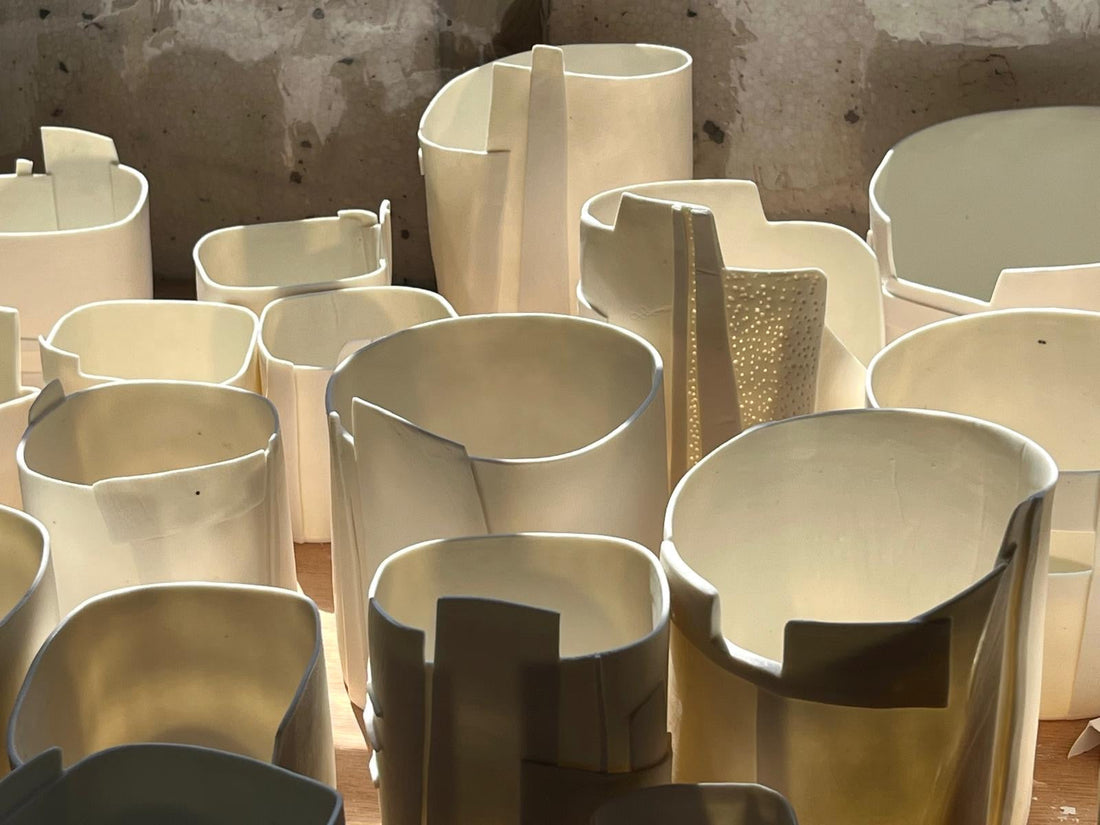We use cookies to ensure you have the best experience on our website.
4 - 28 September 2025: Domestic Materials by Jane Bowen

Private view Wednesday 3rd September 6-8pm
In her own words, "I’ve played with ideas around making, and giving a new platform to the everyday by using a variety of materials and processes. Through exploring the history and meanings behind domestic objects, crafts and skills, this body of work aims to re-evaluate power structures and rhetoric around the status of different materials and those who work them."
Jane Bowen graduated from Camberwell School of Art in 1989 and went on to work in potteries in Delhi and then North Devon before apprenticing to Clive Bowen. She set up her first pottery in Northmoor in 1995 and now works from her studio in Tackley with husband Dylan.
We asked her a few questions ahead of her exhibition.
Talk us through a few of the materials and processes you’ve explored for the work in this exhibition? Elaborate a little on the power structures, histories and meanings you’re looking at?
I’ve used both terracotta and porcelain for this work. The terracotta is hand built with a few thrown elements and the porcelain hand-built, thrown, press moulded or slipcast from objects like scourers, crocheted string or raffia, cardboard, cloth etc.
These materials and objects each have their own status within our societies for many reasons, but what is their true value?
Im interested in the hidden hands behind the manufacture of these objects and who then goes on to use them to patch and nurture the fabric of our societies. Who are the people who silently, steadily, and continuously make, sew and weave together the essential and fundamental structures of our families and communities?
How did you end up working with clay and what drew you to it as a material?
I was lucky enough to do pottery at school aged eleven, and decided almost instantly that I wanted to “be a potter.” I just got such a thrill from building with this lovely soft material and then seeing the solid transformation from the kiln.
The combination of control and surprise suited me. I also loved the musty smell of the clay in the room - still do.
You work with both terracotta and porcelain - what are your greatest loves for these seriously different materials and what drew you to each of them?
Well, one can do what the other can’t and I’ve always been fascinated by contrast and contradiction. They each impose different sets of rules and demand entirely different treatment, both being “right” in their own way.
Terracotta allows me to build very freely; It is inexpensive and plastic and can be easily messed around with by adding sand or another clay to change its texture and using slips/glazes to vary its colour.
Porcelain is very different: it shows every mark of making, for better or worse, and though it generally needs time and care it has to be worked fairly fast before it dries out and starts cracking. But, the results can be very rewarding as it offers light and purity as well as strength and fragility.
When visiting your space, you can definitely get a sense of busy hands, working not only with clay but with a curiosity in pen to paper, weaving, sculpture and so on. How do you explore these other materials - does it always end in clay?
Sometimes I want to make something in particular or I have an idea and I think what would be the best way to make that and with what? I like working these things out and this process tends to lead to other thoughts and materials.
Other times I see a material or a technique I really want to use so I have to decide what to make with it; it’s kind of the other way around. I think all of the making feeds into the ceramics in the end but not necessarily in a linear way.
You studied ceramics and have apprenticed in potteries in the UK and abroad, having worked with clay for so long can you tell us how your practice has grown and changed and maybe the influences that made that happen?
I’ve always been interested in what clay can do, I mean from the lowest temperature to the highest, and even at art school I was showing pieces which were low fired raku and high-fired porcelain together, so I’ve never really believed in narrowing down options. I’m lucky to have had some really traditional training and over time I suppose I’ve allowed myself to work with this and move my own practice forward without being restricted by it.
My influences are so many and I realise now that they have become integrated and that they are all the things and people that have left an imprint on me.
I studied Ceramics not Art and didn’t do a foundation course beforehand and felt I’d missed out a bit. I think I’ve been doing a foundation course ever since.
What is your favourite part of your process?
Making.
What sights affect and influence you on a regular basis?
Building sights, trees, white washing on the line, industrial areas in the countryside, like a working quarry.
And finally; who is a maker whose work you love and admire that we should know about but may not have heard of?
Gillian Lowndes, who I’m sure you have heard of. Also Lucio Fontana’s ceramic crucifixes are wonderful.
What is the most recent ceramic vessel or piece of pottery you bought for yourself, from where and by whom?
A lovely generous tea bowl by Tarragon Smith at Ceramic Art London.